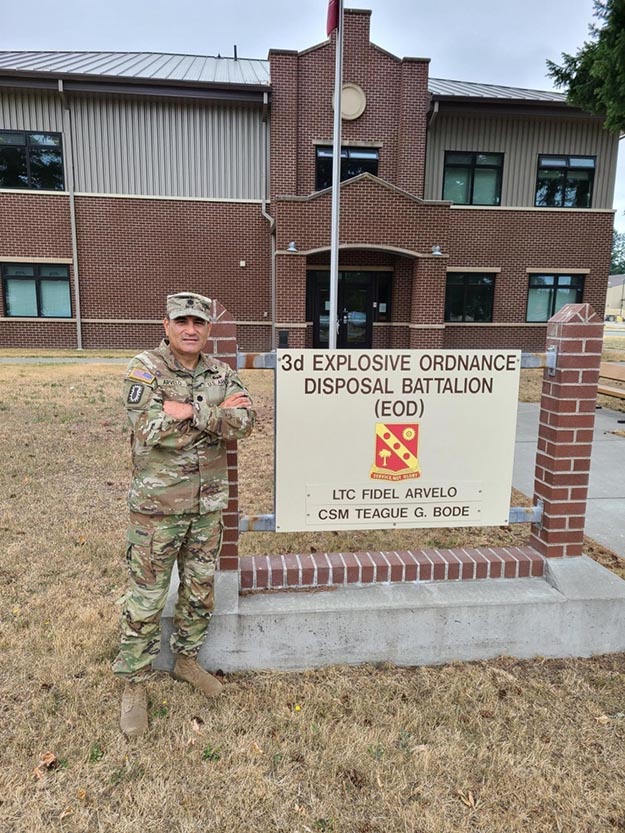ABERDEEN PROVING GROUND, Maryland - U.S. Army Explosive Ordnance Disposal technicians save lives and enable operations by confronting and defeating everything from hand grenades to nuclear weapons.
Across the nation and around the world, EOD soldiers take on the explosive devices that can harm people and hinder operations during combat missions and training exercises.
Lt. Col. Fidel Arvelo, the commander of the Joint Base Lewis-McChord-based 3rd EOD Battalion, has served as an EOD officer for 19 years. He started as an enlisted EOD technician before becoming a warrant officer and a commissioned officer.
A native of Rio Grande, Puerto Rico, Arvelo became an EOD technician in 1990 after serving as a combat engineer because he was drawn to the challenging nature of the career field.
After 35 years in the U.S. Army, Arvelo's bio reads like a history lesson. In addition to multiple combat tours in Iraq and Afghanistan, Arvelo supported EOD responses in Mogadishu, Somalia, during the 1993 raids that were depicted in the movie Black Hawk Down and he also helped to rescue a Bedouin from a minefield on the Sinai Peninsula in Egypt.
Calling his battalion command his best experience, Arvello said the EOD profession requires a special kind of soldier who can accomplish difficult missions with minimum oversight.
"EOD is easily the most rewarding job in the Army," said Arvello. "Sergeants and staff sergeants are trusted to take their team members anywhere in the world and coordinate with supported organizations for the safety and protection of those they are called to protect.
"Young officers are expected to learn all the technical requirements of disarming and rendering safe explosive hazards as well as lead their platoons and companies to deploy overseas as their own small separated element, supporting (Special Operations Forces) or conventional forces," said Arvello. "An exceptional opportunity but not for the faint of heart."
When a 120mm round got stuck in the barrel of an M1A1 Abrams tank on Fort Irwin, California, Staff Sgt. Caleb S. Canales and Sgt. James L. Phan, EOD technicians from the 759th EOD Company, 3rd EOD Battalion, 71st EOD Group, 20th CBRNE Command, were called to the training range to remove the live round.
Arriving on scene on the 100-plus degree day, the EOD soldiers attempted non-explosive procedures to extricate the munition. When that didn't work in the hot and cramped tank, they tried something else - using explosives and water.
"We filled the tank barrel with water to act as a tamper for our C4 blast," said Canales, who is originally from Corpus Christi, Texas. "By doing this, we were able to direct the blast wave down, so that the tank projectile came out of the breach and not out of the barrel."
With the 50-pound round safely removed, the tank remains mission ready.
Solving dangerous and complex explosive problems is what Army EOD technicians do every day. Not only do they defeat dangerous devices during operations but they also render safe unexploded ordnance, on and off post, with an average of 130 responses per month.
Every day, Army EOD soldiers serve with joint, interagency and allied partners around the world. On a regular basis, these elite Army units also conduct missions to protect the president, vice president and their families as well as foreign heads of state and they train allied forces in demolition, minefield clearance and explosive safety.
For more information, go to https://goarmysof.com/eod/eodrecruiting.html. You can also contact the EOD In-service Recruiters on Fort Bragg, North Carolina, at (910) 432-1818 or Joint Base Lewis-McChord, at (253) 966-3902.





Read Comments